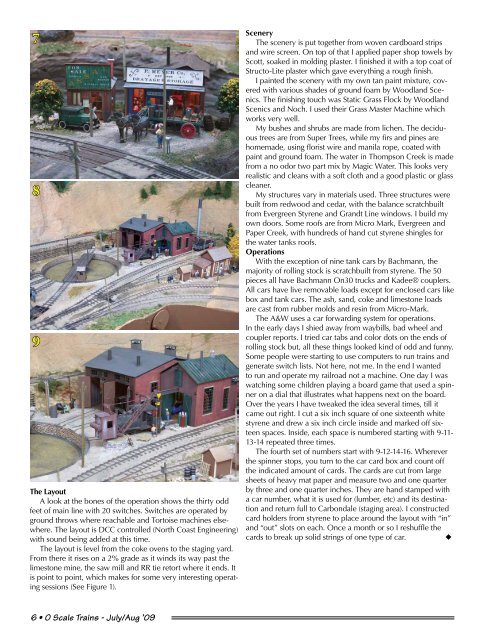Download - O Scale Trains Magazine Online
Download - O Scale Trains Magazine Online
Download - O Scale Trains Magazine Online
- No tags were found...
You also want an ePaper? Increase the reach of your titles
YUMPU automatically turns print PDFs into web optimized ePapers that Google loves.
789The LayoutA look at the bones of the operation shows the thirty oddfeet of main line with 20 switches. Switches are operated byground throws where reachable and Tortoise machines elsewhere.The layout is DCC controlled (North Coast Engineering)with sound being added at this time.The layout is level from the coke ovens to the staging yard.From there it rises on a 2% grade as it winds its way past thelimestone mine, the saw mill and RR tie retort where it ends. Itis point to point, which makes for some very interesting operatingsessions (See Figure 1).SceneryThe scenery is put together from woven cardboard stripsand wire screen. On top of that I applied paper shop towels byScott, soaked in molding plaster. I finished it with a top coat ofStructo-Lite plaster which gave everything a rough finish.I painted the scenery with my own tan paint mixture, coveredwith various shades of ground foam by Woodland Scenics.The finishing touch was Static Grass Flock by WoodlandScenics and Noch. I used their Grass Master Machine whichworks very well.My bushes and shrubs are made from lichen. The deciduoustrees are from Super Trees, while my firs and pines arehomemade, using florist wire and manila rope, coated withpaint and ground foam. The water in Thompson Creek is madefrom a no odor two part mix by Magic Water. This looks veryrealistic and cleans with a soft cloth and a good plastic or glasscleaner.My structures vary in materials used. Three structures werebuilt from redwood and cedar, with the balance scratchbuiltfrom Evergreen Styrene and Grandt Line windows. I build myown doors. Some roofs are from Micro Mark, Evergreen andPaper Creek, with hundreds of hand cut styrene shingles forthe water tanks roofs.OperationsWith the exception of nine tank cars by Bachmann, themajority of rolling stock is scratchbuilt from styrene. The 50pieces all have Bachmann On30 trucks and Kadee® couplers.All cars have live removable loads except for enclosed cars likebox and tank cars. The ash, sand, coke and limestone loadsare cast from rubber molds and resin from Micro-Mark.The A&W uses a car forwarding system for operations.In the early days I shied away from waybills, bad wheel andcoupler reports. I tried car tabs and color dots on the ends ofrolling stock but, all these things looked kind of odd and funny.Some people were starting to use computers to run trains andgenerate switch lists. Not here, not me. In the end I wantedto run and operate my railroad not a machine. One day I waswatching some children playing a board game that used a spinneron a dial that illustrates what happens next on the board.Over the years I have tweaked the idea several times, till itcame out right. I cut a six inch square of one sixteenth whitestyrene and drew a six inch circle inside and marked off sixteenspaces. Inside, each space is numbered starting with 9-11-13-14 repeated three times.The fourth set of numbers start with 9-12-14-16. Whereverthe spinner stops, you turn to the car card box and count offthe indicated amount of cards. The cards are cut from largesheets of heavy mat paper and measure two and one quarterby three and one quarter inches. They are hand stamped witha car number, what it is used for (lumber, etc) and its destinationand return full to Carbondale (staging area). I constructedcard holders from styrene to place around the layout with “in”and “out” slots on each. Once a month or so I reshuffle thecards to break up solid strings of one type of car. u6 • O <strong>Scale</strong> <strong>Trains</strong> - July/Aug ’09
















